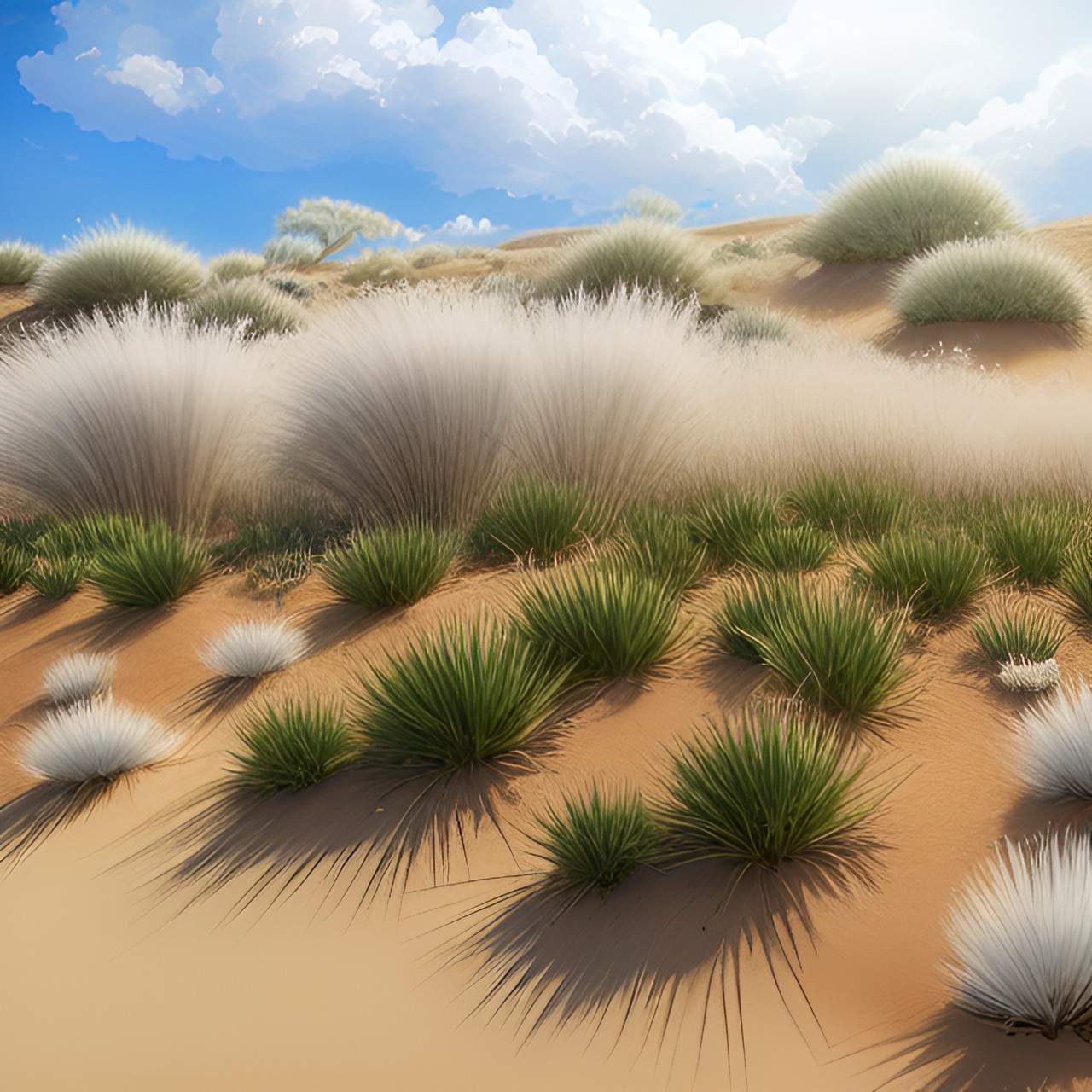Jari Tamal
There are many strange sights in the Shamsi Desert and this desert bunchgrass is among them. It can be almost comedic to watch tuft after tuft of white-leaved grass shuffle across desert dunes, seeking the sunniest perch or water deep below the sand! Sometimes Jari Tamal is called running grass as this is no sedentary species, its roots capablae of freely navigating through sand. For this reason, Jari Tamal is found all across the deserts of Alkelbulan and the Frozen Wastes. It is also called fast grass for its rapid growth into dense bunches, sprouting anew even when its leaves are totally or eaten! Persisting even in the salt marshes, beaches and salt pans of Alkelbulan, they are unbothered by saline soils or drought. But these grasses are more than just hardy and mobile, they nurture life in their desolate habitat! Whether filling the bellies of herbivores or protecting the saplings of Murna Acacia, Jari Tamal is an essential componant of desert ecosystems.
The rapid growth of Jari Tamal can be attributed to their Charge manifestations, absorbing and storing sunlight, ice or radiation depending on their habitat. While this energy can be used in self defense, most often these grasses use it to bolster their own growth! This is part of why Jari Tamal can regrow so long as its roots remain intact. Not all Jari Tamal are mobile but are far more tenacious. Those inheriting Aasaru's Touch have grasping blades which attatching new clonal growth to anyone who makes contact, feeding on their magic energy. The purpose is propogation, hitching a ride on grazers and passerby and growing into a new bunches wherever they are shaken off. It isn't uncommon to find several of them stuck to you when wading through tufts of desert grass, leeching one's energy away however slowly.
|
First AbilityRithaldis' Charge Those with Rithaldis' Charge can store up radiant energy inside their bodies without limit and cannot be harmed by radiant energy, natural or magical. This includes sunlight, radiation and solar plasma. They can convert this to energy, bolster their own growth or re-release the energy like an Aura. However, unlike most forms of magic they cannot produce radiant energy on their own, dependant on an outside source.
Iska's Charge Thanks to Iska's Charge, these grasses can store up ice or extremely cold temperatures inside their bodies without limit and cannot be harmed by the same, magic or natural. They can convert this to magic energy, boster their own growth or re-release the energy as an Aura. However, unlike most forms of magic they cannot produce their aspect on their own, dependant on an outside source.
Second AbilityIlnid's Movement Those with Ilnid's Movement are able to move on or through sand, quartz and glass freely. They can move about in these materials as though they were swimming in water. They are extremely mobile but can be slowed down by foreign objects or dilutions of these materials.
Aasaru's Touch Aasaru's Touch allows these grasses to infest those it touches with small clones of itself capable of growing into fully mature plants. These can also sap magic energy from a victim if the caster choosesto, transfering it to the parent or using it to grow and mature rapidly.
|
Anatomy |
The stems of this grass jointed, hard and polished similarly to bamboo shoots. Side shoots branch out at the nodes and stems will bend over and root when they become buried in sand. The roots are covered in hairs which adhere to sand, fibrous, stout and felt like. Stiff leaf blades alternate along the stem.
|
Habitat |
This grass can be found across the Shamsi and Arabiyyan Deserts, Birit Narim, Parsa, Xishi Shamo, Kasar Wuta and all across the Frozen Wastes. It prefers dry and sandy soils, growing in sandy deserts and semi-deserts. It roots itself on dunes and seashores or sandy pockets in rocky outcroppings, very long roots reaching subterranean waters. It will tolerate loamy, saline and nutritionally poor soils but prefers well drained, mildly acidic or basic sand. It requires a sunny position. |
Life Cycle |
Dormant buds will sprout rapidly once the rainy season begins, staying green throuhout the season and flowering during this period. The flowers are pollinated by wind and seeds germinate in temperatures over 59 F (15 C). While it is possible to transplant seedlings, vegetative growths are the most common form of reproduction for Jari Tamal. Having several methods of asexual cloning, new sprouts can spread through stolons, rhizomes, cuttings, self division or even via their touch manifestation!
The seeds are difficult to harvest in quantity because they mature at different times over an extended period, shatter easily and are often eaten by birds. However, this plant is able to photosynthesize more efficiently than most other plants, especially in high temperatures, bright sunlight and dry conditions—perfectly evolved for its environment. It's naturally rapid growth and efficiency in processing sunlight has only been amplified further by its magic. |
Uses |
The seeds of these grasses can be eaten in a soup or ground into a flour to make into bread or porridge. The grains can be stored away for times of scarcity as well. Ants have been known to store this grain in their nests and people will raid these in desperate times. Young shoots of these grasses have a sweet flavor and the burnt and powdered roots are made into a kind of soda.
Hollow stems can be dried and powdered and used for wound dressing. The seed is also believed to be helpful in treating diabetes. Its straw is very stiff, commonly woven into mats, baskets and rope or used in thatching. The hollow stems can also be used as firewood in the desert. While not a preferred fodder, Shamsi Camels and donkeys will eat it and younger specimens are suitable to sheep and goats. However, herdsmen find their cattle's milk becomes foul smelling after several days of grazing this grass. |










Comments